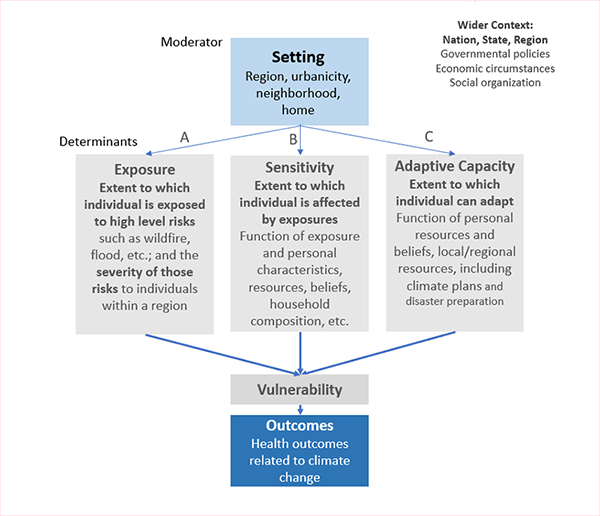The Homes and Neighborhoods of Older Adults Shape Their Vulnerability to Climate Change
Population aging and climate change are both reshaping how we think about housing, compelling us to consider where we build, the materials we use, the features that we consider essential in a home, and more generally how housing and neighborhoods contribute to health. Yet while much has been written about the physiological consequences of climate change for older adults, less is known about how residential settings shape the extent to which older people are exposed to climate stressors like severe heat or wildfire smoke, their sensitivity to these stressors, or their capacity to respond to extreme events or adapt to long-term environmental changes.
To help fill this gap, Ann Forsyth and I review the largely separate literatures on climate change, aging, and housing in a new paper for Housing Policy Debate. We examine how communities, neighborhoods, and homes influence older adults’ vulnerabilities and wellbeing in a changing climate. We also detail several areas where we believe more research is needed on these critically important questions.
Because older adults are more likely to have chronic conditions and disabilities, they are generally at greater immediate risk from the effects of climate change. For example, older adults are more likely to have respiratory disease, and therefore may be more sensitive to air quality issues related to increased temperatures, wildfire smoke, and mold and mildew in the home left in the wake of severe storms and flooding. Higher rates of functional and mobility limitations may make evacuation more difficult in the case of an extreme event, and disruptions to healthcare systems after an event can have serious ramifications for older people with chronic disease.
Yet these risks can be exacerbated or abated by the settings in which older adults live (Figure 1). We focus on community (whether one lives in a core city, suburb, town, or rural area), the neighborhood, and the home, positing that these nested dimensions of residential setting moderate climate risks. For example, while the risk of severe storms, floods, or extreme heat differ by region, they can also vary locally by neighborhood, block, or house. A low-income renter may have little control over temperature or air quality in their building, creating greater exposure and sensitivity to heat, cold, or smoke entering the home through poorly sealed windows. Residential setting also affects older adults’ abilities to cope during and after an extreme event. Those living in high-rise buildings may be stranded in apartments if elevators are not functioning due to lack of electricity, as happened after Superstorm Sandy. Neighborhoods with robust social networks or facilities like cooling centers, however, can help people cope during extreme heat.
Figure 1: Residential Setting as Moderator of Climate Change Threats

Our model includes a number of feedback loops. Living in poor quality housing in a rural location with few medical providers may predispose people to poorer health, which can be exacerbated by wildfire smoke or mold, for example. Meanwhile, a lack of resources in the community may limit funds to repair housing after a climate event, further contributing to poor health and increasing vulnerability in another disaster.
Of course, where one lives is closely tied with socioeconomic circumstances. Individuals’ choices about where they live are often limited, raising important equity considerations about who can relocate out of harm’s way, retrofit their homes to better withstand flooding or wildfire risk, or add features like air conditioning.
Our review suggests several topics merit further exploration. First, we need more research directly examining the intersection of climate, aging, and residential setting to better understand older people’s sensitivity and capacity to bounce back from climate stressors. Next, we need more information about how older people differ by income, race, and ethnicity in the context of climate change exposure, sensitivity, and adaptation. Third, we need more insight into how older adults perceive climate risks. Additionally, there is a gap in knowledge about who is most likely to engage in adaptative behaviors such as moving or modifying a home, and how to best address barriers that people face to adaptation. While wealthier people have more financial resources, moves to scenic but vulnerable coastal communities in retirement may increase their risk. Renters may have fewer housing options and little control over climate-resiliency upgrades to their homes, and low-income homeowners may lack the resources to retrofit for climate risks.
Population aging and climate change are informing the work of urban planners and policymakers. Yet by recognizing that people experience and manage climate change threats in complex landscapes (literally), and by addressing the current gaps in research, we can help ensure that solutions are effective, holistic, and consider the unique vulnerabilities of people of all ages.

